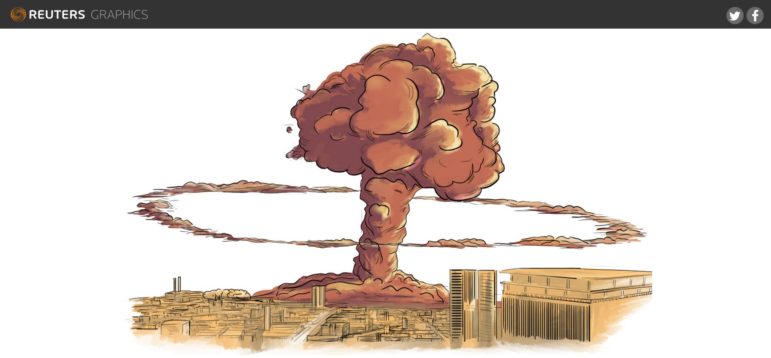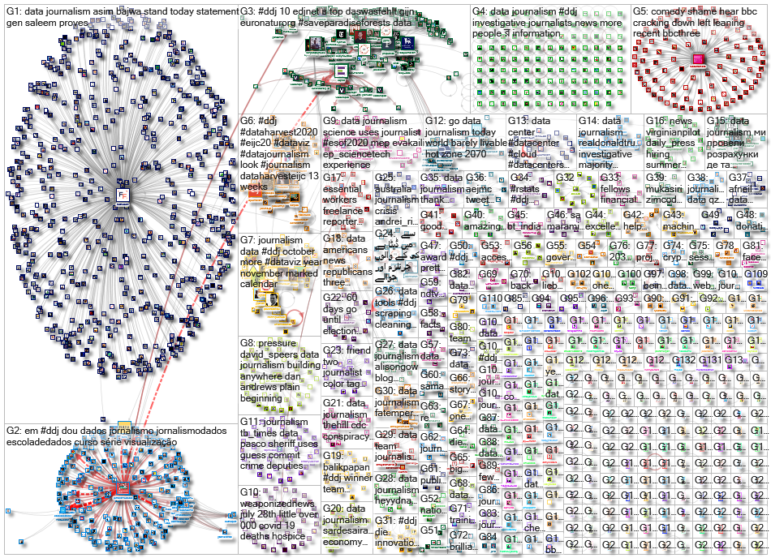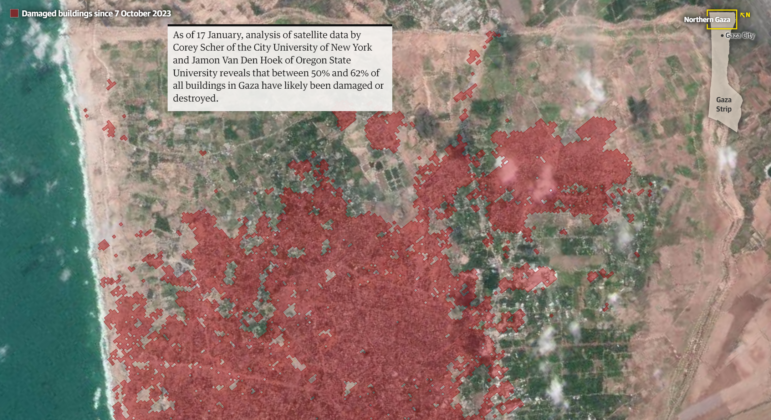

Data Journalism Top 10: Beirut Blast, Predicting Crime, US Election Simulators, and COVID in Ukraine
What was the magnitude of the Beirut port blast and how did it compare to other infamous explosions in history? Our NodeXL #ddj mapping from August 31 to September 6 found Reuters illustrating just how powerful last month’s blast was in relation to the Chernobyl disaster and other events. The Tampa Bay Times highlighted how a county sheriff’s office is using an algorithm to supposedly predict and intercept the criminals of the future, while The New York Times used satellite maps to show how physical and political geographies interact across the United States. ESPN has been looking into the potential of people in college football crowds to become COVID-19 super-spreaders, and Slate analyzed overuse of the word “murmur” in the popular Twilight novel series.
Visualizing Beirut’s Mega-Blast
Last month’s massive port explosion in Beirut, Lebanon, killed at least 172 people, injured more than 6,000, and left a trail of devastation. Experts estimate the size of the blast as being the equivalent of 200 to 300 tons of high explosives, dwarfing the Chernobyl disaster in 1986 (10 tons) and a warehouse explosion in Tianjin, China, in 2015 (21 tons). Reuters visualized the Beirut blast in comparison to these other events, including the atomic bombing of Hiroshima during World War II.
Minority Report, Florida-Style
Imagine a technology that predicts future crimes so that police can catch potential criminals before the crimes are committed. Sounds like the plot of the sci-fi movie and novel “Minority Report,” doesn’t it? Turns out a county sheriff’s office in the US state of Florida thinks it has built a similar system. The Tampa Bay Times reported that the sheriff’s office generates a list of people it considers likely to break the law, based on algorithm inputs of arrest histories, unspecified intelligence, and arbitrary decisions by police analysts. Following that, its officers locate and interrogate these individuals, often without probable cause.
Mapping the Habitats of Threatened Species
The Irrawaddy dolphin, found in coastal areas of South and Southeast Asia, has declined in numbers in recent decades and is classified as endangered. Kompas.com contributor Zakarias Demon Daton and his team created an informative piece mapping the habitat of this near-extinct species and outlining the threats it faces. Their entry won in a virtual environmental data hackathon in Balikpapan, Indonesia.
US Electoral College Simulator
The outcome of the US presidential election this November relies heavily on voting results in swing states, with candidates needing to reach 270 electoral college votes to win. The New York Times created a cool simulator for readers to build their own coalition of states to see the potential outcomes in the 2020 race between Democratic candidate Joe Biden and the Republican incumbent, Donald Trump.
COVID-19 Risk in Ukraine Schools
Inspired by an interactive piece in The New York Times, Ukraine’s data journalism agency Texty.org.ua calculated the potential number of infected students who might attend school when the semester begins in Ukraine in September. The bigger the school, the greater the risk. The team included an interactive chart for readers to search for likely health risks at their own schools.
The Colors of America’s Political Divide
The New York Times wanted to find out if the natural colors of American neighborhoods — green or gray based on rural or urban geographies, and taken from satellite images — could indicate voting patterns. Using powerful computers to process aerial imagery of every square meter where votes are cast, the team found that Democratic voters tend to live in grayer toned areas, while Republican voters are located in greener areas. See a snapshot of this story in print here, and a peek at the behind the scenes process here.
Twilight Murmurs
Have you ever read a novel and realized that the author constantly repeats a particular word? Slate staff writer Rachelle Hampton noticed that famed Twilight author Stephenie Meyer is extraordinarily fond of the word “murmur.” Hampton carefully counted, charted, and analyzed every “murmur” that appeared in Meyer’s books (and found 349 of them). Check out her analysis of the book with the most murmurs, the character that murmurs the most, and the things being murmured into.
Football: Super-Spreader Events?
College football is a huge part of the American sports landscape and something fans eagerly look forward to, but how will game organizers adapt matches to the risk of COVID-19 this season? ESPN used anonymized cellphone tracking data to map out fan movements after football games, and highlighted the risks of college football becoming super-spreader events despite current restrictions.
Trust in the Media. Or Not.
Many Americans remain skeptical towards the news media, doubting not only the quality of journalists’ work but the intentions behind it. The Pew Research Center’s study finds that most Americans (72%) perceive a lack of transparency by news organizations, particularly when it comes to financing, and only about half (48%) have a fair amount of confidence in journalists to act in the best interests of the public.
Betting and the Polls
Although most polls show Democrat Joe Biden in the lead in the 2020 US presidential race, betting markets have shifted dramatically in President Trump’s favor since the Republican national convention. The Financial Times’ data reporter Christine Zhang looks into — and explains — the disconnect between national polling and those betting in the prediction markets. Zhang’s colleague John Burn-Murdoch tweeted a short summary here.
Thanks again to Marc Smith and Harald Meier of Connected Action for gathering the links and graphing them. The Top Ten #ddj list is curated weekly.
 Eunice Au is GIJN’s program manager. Previously, she was a Malaysia correspondent for Singapore’s The Straits Times, and a journalist at the New Straits Times. She has also written for The Sun, Malaysian Today, and Madam Chair.
Eunice Au is GIJN’s program manager. Previously, she was a Malaysia correspondent for Singapore’s The Straits Times, and a journalist at the New Straits Times. She has also written for The Sun, Malaysian Today, and Madam Chair.
For a look at NodeXL’s mapping on #ddj and data journalism on Twitter, check out this map.










